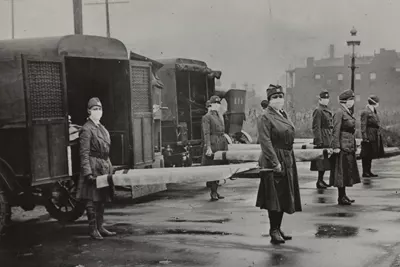Impact


"Female medics holding stretchers" Library of Congress 1918
The 1918 Spanish Flu impacted the world socially and economically (“Influenza - Destroyer…” 367). The aftermath of World War I left the people unprepared to fight a pandemic (“Medical Innovations…”). In the United States alone, the flu killed 400,000 people in under twelve weeks. The flu affected the world’s economy, causing a loss of over three billion dollars. Bankruptcy of the nation’s health administration left many patients without proper care, due to the lack of hospitals and health care facilities. The pandemic also promoted discussions and arguments among the health care workers concerning the closure of public buildings and schools in certain cities and countries. The arguments were centered around the fact that closing the buildings may cause overcrowding in other areas (“Influenza - Destroyer...” 368). Overcrowding was unadvised, for having a large number of people in one place was the main way of easily spreading the influenza (“Mobilizing Social Forces…” 95). The doctors were all in agreement that controlling the fear of the people was one of their main priorities. The Health Commissioner of Chicago, Doctor Robertson, states, “Worry kills more people than the epidemic” (“Influenza - Destroyer…” 368).

The flu pandemic not only affected the social and economic landscape of the world, but also spiked ideas in the minds of people looking to make money from the pandemic through scams and fake remedies. Their ideas were advertised and distributed through pamphlets, newspapers, and other various means of communication (Shoshone journal). Attempts to have bonds purchased "last minute" were also advertised especially in Delaware. As an incentive, if purchased, the name of the buyer would appear on a "Special Honors List" (Evening journal). The pandemic was viewed by many as a way to innovate the medical society, while others viewed it as a way to benefit themselves (Shoshone journal).
"Pamphlet advertising Laxcarin" Library of Congress 1918